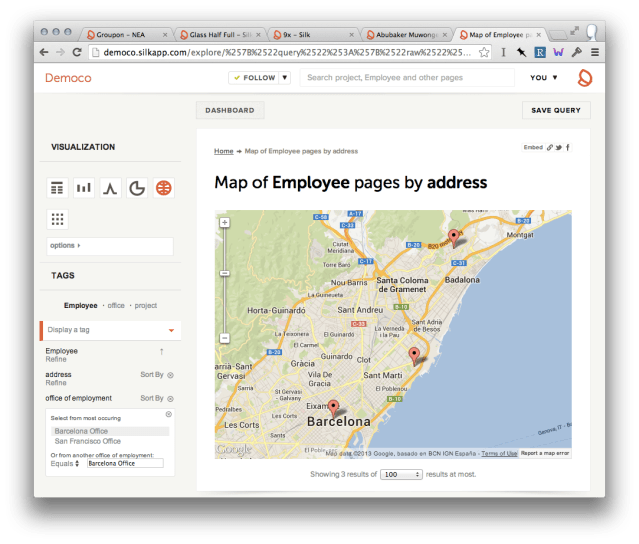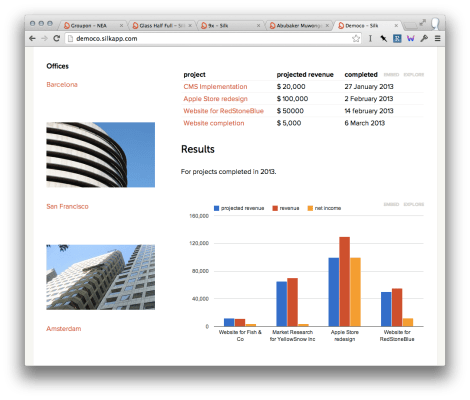Since Silk first came out of stealth mode in 2011, there have been 300,000 interactive pages created on its cloud-based, web data-crunching platform designed for non-technical “knowledge workers.” Taking less easy-to-read data sets and making them more digestible, results have ranged from the Guardian newspaper in the UK creating graphics of which countries have the most asylum seekers, through to charting what products Google has killed and dads mapping out the best playgrounds for his kid in Amsterdam (where Silk also happens to be founded). It’s been a popular, and free, tool, with pages created by some 16,000 people growing by 20 percent each month. Now, Silk is moving on to its next phase: its first paid product, Silk for Teams, aimed at groups of enterprise users who want to use the platform to produce cleaner internal data sets, and eventually to create data visualizations that work with paywalls.
The company (now dropping its silkapp.com URL for a shorter silk.co) is also announcing an extra $1.6 million from existing investor NEA as part of the news, which will also be used to help Silk continue expanding into the U.S. market and add more features to the paid product. This brings the total raised by Silk to $3.7 million, after previous funding from NEA, Atomico Ventures and a number of prominent angels.
Salar Al-Khafaji, the co-founder and CEO of Silk, describes Silk as the everyday user’s equivalent of MongoDB, the NoSQL database startup that last week announced a hefty $150 million raise to help enterprise IT specialists take on broad sets of structured and unstructured data — in other words, information that may already be in some dabase-style format, combined with data that is not.
“What MongoDB does for technical people is what we are trying to do for less technical people,” he tells me.
This results in pages that not only bring together data, but that also let users manipulate it and reset parameters for viewing in real time, such as in this example to query a database of employees (the menu is in the left-hand column):

Al-Khafaji says he declines to use the term “big data” for Silk. He says it has been thrown around too much and could mean anything these days. Still, this seems to be what is at play here, with the promise being that Silk will make big data something that everyone can access, and do so much quicker than before.
These seem to be some of the drivers of what beta testers have been valuing in the product so far. “Before Silk, it was incredibly time consuming to keep track of the voting patterns on amendments. And building graphics to show our findings was also difficult and required an expert resource,” Stephen Northfield, director of digital at Human Rights Watch, noted in a statement. “Silk lets our non-technical staff convert years of data into beautiful interactive maps and graphics. This allows our team and anyone else the ability to study voting records from almost any vantage point with just a few clicks.”
The promise of what Silk can offer to enterprises should not sound unfamiliar: the idea of creating IT services that let non-IT people take better control of the data they need to do their jobs is one that we’ve been seeing a lot lately, part of the bigger trend for consumerization in IT.
Others that have specifically created “consumerized” platforms for database management include Looker (which lets you use natural language for database queries), Good Data, Origami Logic specifically for marketers, Import.io to help create datasets from unstructured data, Visual.ly to make visualizations of data, and many more. Typical examples of where a platform like Silk might come in handy are for project managers, those working in CRM or marketing and market analysts, in theory competing directly against some of these other companies, or at least aspects of their offerings.
Silk for Teams will be charged in a typical SaaS fashion. The public service will remain free, as will a private service for up to three people. After that, it will be charged at $10 per user per month. On top of that there will be support services available to paid users.
Meanwhile, with the extra funding comes a re-doubled effort to target business in the U.S. This is something that Silk has already been doing, notes Al-Khafaji, an engineer by training who spends part of the month with Silk’s sales people in San Francisco, and the other part with Silk’s development team in Amsterdam. He says that the double focus is here to stay, following in the footsteps of a number of other startups from this side of the pond that have kept engineers developing away at home while the bizdev people do their thing in the Valley (two notable recent exits in that vein are Waze and Tursteer). “We are going to keep our company on both sides of the ocean,” he tells me.
Having the team split between two continents hasn’t impacted fundraising too much for the company, he says. “Atomico is run by product people, and they simply just liked our product,” he notes, while “NEA literally sees us as a tech company, and it doesn’t matter where we are based.” However, he does note that some VCs felt otherwise. “When we raised money some were clear that they wound’t fund us unless we moved completely to the U.S.,” he said.
Going forward, it looks like the Teams and more enterprise products will be getting further enhancements. One area will be to share the more sophisticated data sets created for internal purposes with paying customers. This is something you could imagine getting used by newspapers with paywalls for part of their content, or analyst houses encouraging users with freemium models, as two examples. The payments side of the product isn’t open yet, Al-Khafaji tells me, but it is coming soon.
